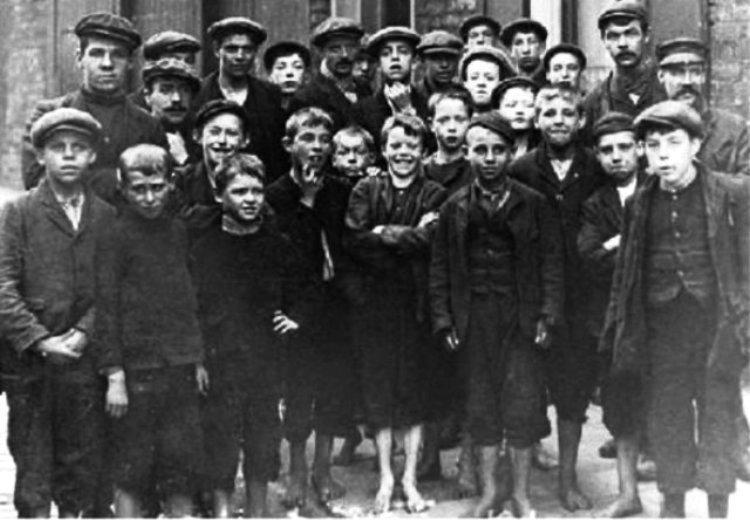
Liverpool General Transport Strike (1911)

Figure 1.--This photo was taken during the Liverpool General Transport Strike (June 14-August 14). We are not sure who the boys are, presumably the chikldren of striking workers. All the young boys depicted in the photo are barefoot, but many of them are wearing jackets and vests.
|
|
Standard histories of Britain and the United States during the late-19th and early-20th centuries commonly focus on low industrial wages and price goughing by capitalists. It is certainly true that many workers survived on low wages. A major factor here is that the British worker and British industry were not very efficient and competitive with workes and industries in other countries. Industrial wages declined in Britain by about 10 percent (1900-10). Inflation causing wide-spread price increases put increasing pressure on the working class. The Liverpool strike movement was one one of the major events during this period of pronounced industrial unrest that affected British industry between 1910 and the outbreak of World War I. It began with a walk-out of seamen. The National Sailors' and Firemen's Union announced a nation-wide merchant seamen's strike (June 14). Union solidarity led to other workers joining the action. The workers formed a strike committee to negotiate. Syndicalist leader Tom Mann chired the Comittee. The center of the unrest was Liverpool, Britain's major port with a substantial Irish Catholic population. Striking workers organized mass meetings on St. George's Plateau next to St. George’s Hall on Lime Street, thecenterof Liverpool. The suze abdintensity of these meetings cased great concern among both industrialists and city officials. The police baton charged a crowd of 85,000 people who gathered to hear strike leader Tom Mann speak (August 13). This soon came to be called 'Bloody Sunday'. Civil unrest sprung up in the city which cintinued during the following night. More than 350 people were injured. The Goverment brought in 3,500 Army troops to help the police maintain order. Soldiers of the 18th Hussars opened fire on a crowd on Vauxhall Road (August 15). There were 15 injuries reported, including two demonstrators killed. One was John Sutcliffe, a 19-year old Catholic carter, who was shot twice in the head. The other was Michael Prendergast, a 30-year old Catholic dock wirker, who was shot twice in the chest. The circumstances of the shooting wre notentirely cear. A subsequent inquest returned a verdict of justifiable homicide. The strike was taken up in other ports and industrial cities. At ts peak more than 70,000 strikers were involved. The strikers included dock workers, railway workers and sailors. Workers from other trades also joined the strike. The strikers succeeded in paralysed Liverpool commerce for some time (much of summer of 1911). The strike had profound political and economic consequences. While the strike was ebded by firce, it transformed trade unionism on Merseyside (Liverpool area) , one of Britain's most important industrual centers and largest oports. Trade unions in Liverpool were able to establish themselves with workers on a permanent basis. It was a major step in becoming real mass organisations representing the working class. It was in the longer term the beginning of the Labour Party and trade unionism as a major political force.
HBC

Navigate the Boys' Historical Clothing Web Site:
[Return to the Main Edwardian Era page]
[Return to the Main English history page]
[Introduction]
[Activities]
[Biographies]
[Chronology]
[Clothing styles]
[Countries]
[Essays]
[Bibliographies]
[Contributions]
[FAQs]
[Glossary]
[Images]
[Links]
[Registration]
[Tools]
[Boys' Clothing Home]
Created: 11:19 PM 9/22/2012
Last updated: 11:19 PM 9/22/2012



